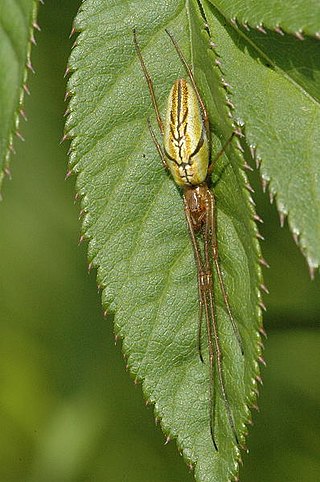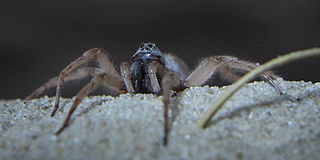
Wolf spiders are members of the family Lycosidae. They are robust and agile hunters with excellent eyesight. They live mostly in solitude, hunt alone, and usually do not spin webs. Some are opportunistic hunters, pouncing upon prey as they find it or chasing it over short distances; others wait for passing prey in or near the mouth of a burrow.

Nursery web spiders (Pisauridae) are a family of araneomorph spiders first described by Eugène Simon in 1890. Females of the family are known for building special nursery webs. When their eggs are about to hatch, a female spider builds a tent-like web, places her egg sac inside, and stands guard outside, hence the family's common name. Like wolf spiders, however, nursery web spiders are roaming hunters that don't use webs for catching prey.

Aelurillus is a genus of spiders in the family Salticidae.

Alopecosa is a spider genus in the family Lycosidae, with about 160 species. They have a largely Eurasian distribution, although some species are found in North Africa and North America.

Lycosa is a genus of wolf spiders distributed throughout most of the world. Sometimes called the "true tarantula", though not closely related to the spiders most commonly called tarantulas today, Lycosa spp. can be distinguished from common wolf spiders by their relatively large size. This genus includes the European Lycosa tarantula, which was once associated with tarantism, a dubious affliction whose symptoms included shaking, cold sweats, and a high fever, asserted to be curable only by the traditional tarantella dance. No scientific substantiation of that myth is known; the venom of Lycosa spiders is generally not harmful.

Hogna is a genus of wolf spiders with more than 200 described species. It is found on all continents except Antarctica.

Tetragnatha is a genus of long-jawed orb-weavers found all over the world. It was first described by Pierre André Latreille in 1804, and it contains hundreds of species. Most occur in the tropics and subtropics, and many can run over water. They are commonly called stretch spiders in reference to their elongated body form and their ability to hide on blades of grass or similar elongated substrates by stretching their front legs forward and the others behind them. The name Tetragnatha is derived from Greek, tetra- a numerical prefix referring to four and gnatha meaning "jaw". Evolution to cursorial behavior occurred long ago in a few different species, the most studied being those found on the Hawaiian islands. One of the biggest and most common species is T. extensa, which has a holarctic distribution. It can be found near lakes, river banks or swamps. Large numbers of individuals can often be found in reeds, tall grass, and around minor trees and shrubs.

Pardosa is a large genus of wolf spiders, commonly known as the thin-legged wolf spiders. It was first described by C. L. Koch, in 1847, with more than 500 described species that are found in all regions of the world.

Allocosa is a spider genus of the wolf spider family, Lycosidae. The 130 or more recognized species are spread worldwide.

Pirata is a genus of wolf spiders, commonly known as pirate wolf spiders.

Trochosa is a large wolf spider genus found worldwide.

Zeria is a genus of solpugid camel spiders, first described by Eugène Simon in 1879.

Hippasa is a genus of spiders in the wolf spider family Lycosidae, first described by Eugène Simon in 1885.
Ocyale lanca, is a species of spider of the genus Ocyale. It is endemic to Sri Lanka.
Ocyale pilosa, is a species of spider of the genus Ocyale. It is a cosmopolitan species found from areas located between West Africa to Myanmar.
Benoitia is a genus of funnel weavers first described by Pekka T. Lehtinen in 1967.
Evippa is a genus of spiders in the family Lycosidae. It was first described in 1882 by Simon. As of 2017, it contains 37 species widely distributed in Asia and Africa.
Evippomma is a genus of spiders in the family Lycosidae. It was first described in 1959 by Roewer. As of 2017, it contains 6 species.

Geolycosa is a genus of wolf spiders first described in 1904.













